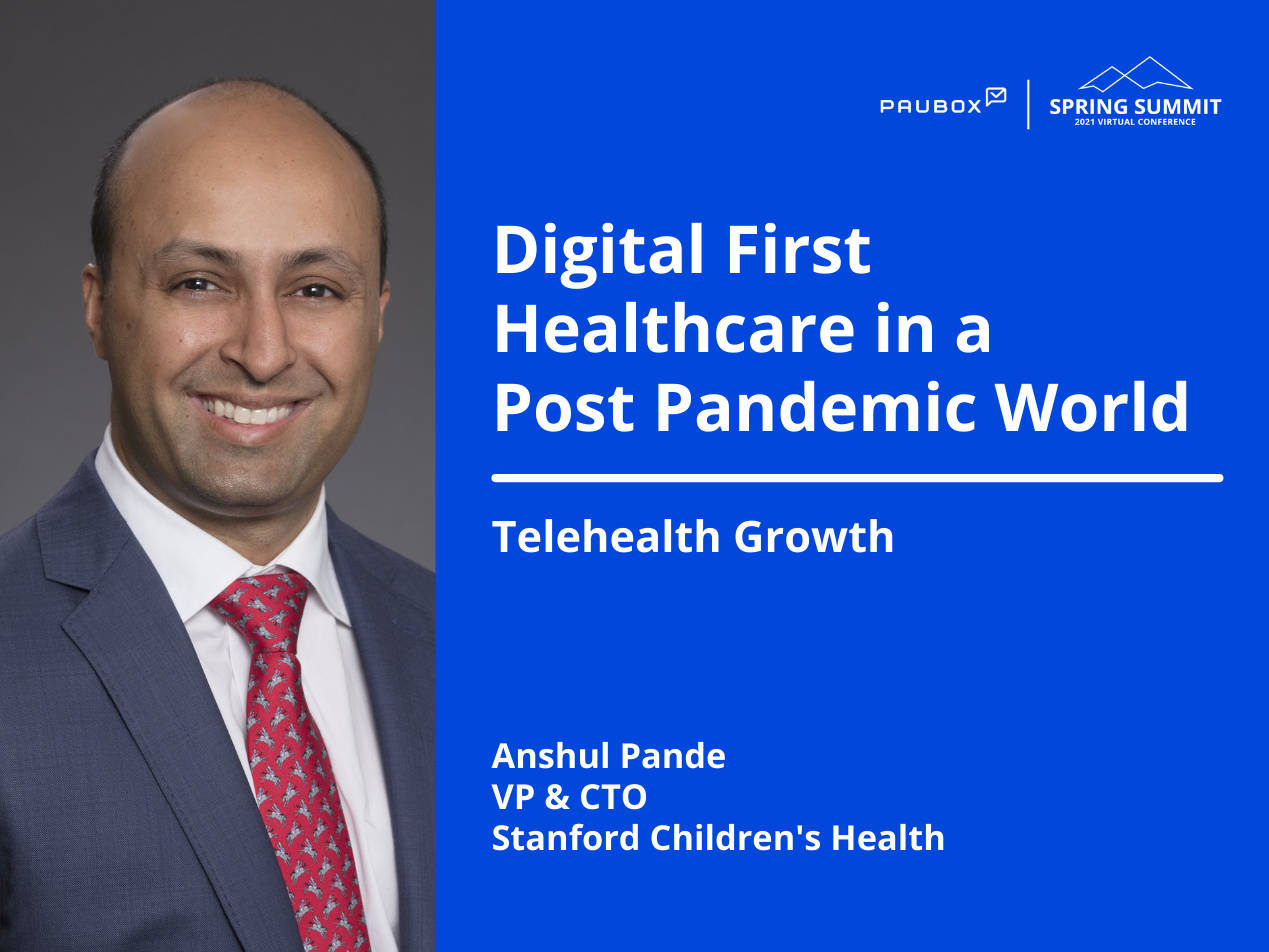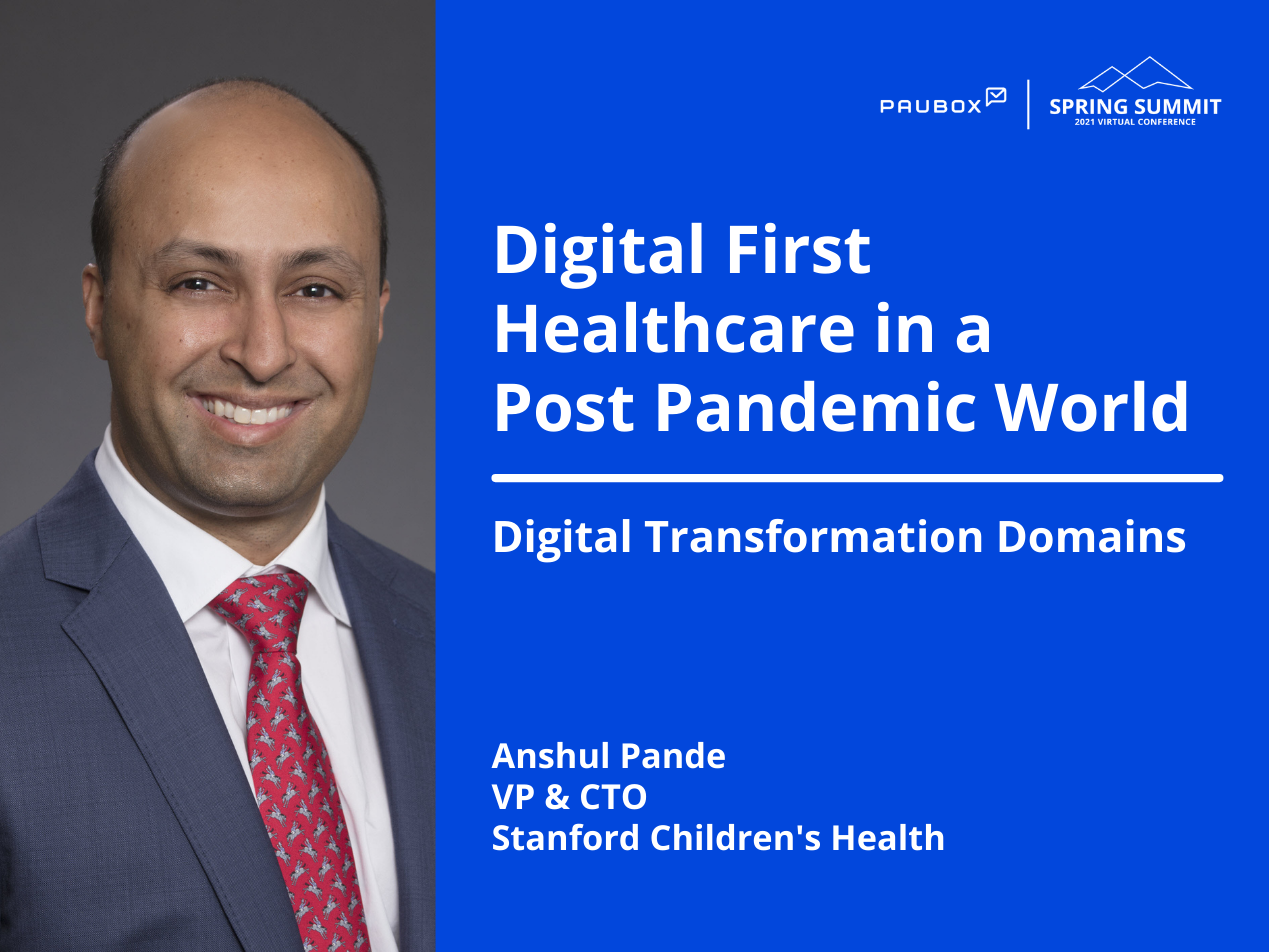4 min read
Anshul Pande: Telehealth growth at Stanford Children's Health during the pandemic
Hannah Trum April 07, 2021

The opening session from Paubox SUMMIT 2021: Secure Communication During a Pandemic. Pande is the vice president and chief technology officer of Stanford Children’s Health, the only healthcare system in the San Francisco Bay Area dedicated to pediatric and obstetric care. It is also one of the few in the country. As CTO, Pande is responsible for all aspects of technology selection, deployment, and delivery for Children’s Health.
Pande explores what digital transformation means in a post-pandemic world and how organizations worldwide can focus on technology as a support rather than a crutch.
Anshul Pande: One of the big silver linings that came out of all of this innovation within the US was how we use telehealth. And this is not just our story, but number of health systems throughout the country who just tremendously grew the telehealth programs during this time.
Here’s one graph, which I’d quickly share with you. And you can see a program predated COVID by many years. So we had a good governance, we had a good framework. But in the early years, it was very purposeful growth, right? So if you look at our FY 16, through 18, or 19, it was a very, very purposeful group. And we were talking to physician groups and asking them who’s interested, we were essentially taking a vote to say, hey, do you want to try this. And if you do, let’s, let’s create a program for you to see how it will fit you.
And then and then COVID head, and you see the numbers out there.
Now, in FY 19, as we were planning for FY 20, our goal was about 7000 telehealth visits. And we thought 7000 was a stretch goal, it’ll be hard to meet that. And we hit about 86,000. Just from a fiscal year perspective, a fiscal year starts in September, with the university’s school year.
So it’s a little odd, it’s it’s not tied to the calendar. And we’ve already hit 100,000 visits for fiscal year 21, which is where we ran a little over six months into it. So again, we’re continuing to see that growth. Now, there were a couple of things that were happening during the crisis, which made this happen. One was, when we talked to the providers, there was really no other way for them to take care of their patients. And when that happens, they are much more likely to adopt and adapt and, and go through the bumps of a new technology implementation.
Another thing was, the patient did not have a choice, the safest way to get healthcare was through telehealth. You don’t have to come to a clinic, you don’t have to be in interaction with people, you’re safely in your house. So you’re socially distance. And thankfully, viruses don’t transmit through telemedicine. So it was great. So at least from a supply side and demand side, there was a deep congruence. And then finally, the federal government pushed in with payment parity, which meant that we were at least getting paid for it. They also allow for certain other rules where, you know, you could do interstate telemedicine and stuff like that. And I hope some of those rules stay, because they will be extremely beneficial for the country in the long run.
Now, when you look at our success and how we achieve 40x growth, we essentially did a few things. One is from a provider perspective, we provided them training one on one, and ensured that their staff who supports them was also trained in troubleshooting the basics of telehealth. And so they didn’t have to wait for it to handle some of the simpler issues till they got comfortable with it. Once you do a few 100 of these, it becomes normal for you. From a patient hesitancy side, if you hadn’t done telehealth, you were not technology savvy.
You know, there’s always this, why am I doing this. And one of the things that we built out was this program to actually call out the patients a day or two before the visit, get them set up, upload the app onto their devices, and actually have them log in and test out telehealth before their actual visit. And all of this was done to make them comfortable with the technology. Make them get through the hesitancy issues with new software being used. And also make them just comfortable that there is somebody that can help them out if needed.
Now, we did this in the early days with our iOS staff volunteering to help out with it. But we have subsequently moved into a service that actually makes these calls and, and gets them set up, especially the first-time telehealth users. The other interesting thing that we worked on was, we knew that if the first experience wasn’t good, it’s going to be problematic. If your first experience with technology is not good, it’ll take you several months to several years to before you try it out again, right. And that’s true for anything.
If your first Facebook experience wasn’t good, you’ll jump to another medium and, and you can see how even social media, things have come and gone just because the next things experience was much better. And the number of people were there. We had to re-platform our video communication system in the midst of COVID because our original system which we had some 16 couldn’t scale up to 40x.
We also have to ensure that the workflows embedded in the EHR, so if a doc was seeing the patient, they could actually see their entire schedule, and click on a button to start the video visit.
Now, this was important for us because we were already thinking about a future world, where it will be a hybrid world, some patients will be seen in person and some people, patients will be seen through video. And whenever you get to that kind of a world, we knew that a single schedule where the provider could actually see that the patient has been in the room and ready and waiting for them, or on a video call and ready and waiting to them be on a same system on the same view, so that they can toggle back and forth between real and virtual.
Finally, we added a whole bunch of features multi-party calling because we also wanted an interpreter to be available. If one of the patient’s parents was not with them, they could connecting from another location. And then the other big aha for us was SMS base meeting links.
One of the things we realize is whereas 81% of the US population has smartphones, the population that actually uses emails consistently is slightly smaller. And the other thing we realize about texting is that it’s quick and simple. The read rate in texting is 90%. Within the first three minutes, the open rate is 98%. And the response rate is 45%.
Now, of course, it’s not secure, there’s a character limit. And you have to be careful about what time you send the text out, right. So you have to send it within the waking hours of that particular market versus emails you could just send anywhere and they’ll accumulate in an inbox and whenever the person wakes up, they can check it out. So lots of learnings out there but texting became a bigger mechanism for us to communicate with our patients.
Watch every minute of Anshul Pande's session here.
Learn more about Paubox Spring Summit, Secure Communication During a Pandemic.
Read a full recap of Paubox Spring Summit.
Learn more about Anshul Pande.
Subscribe to Paubox Weekly
Every Friday we'll bring you the most important news from Paubox. Our aim is to make you smarter, faster.



